

Shinkichi (Kunoemon Oroe) is a young, handsome seller of tobacco. Physically, he is the embodiment of a decent suitor, though at the same time he is inexperienced, immature and lacking economic stability. While working one day he meets Oshiga (Hitomi Kuroki), an older woman, who is as beautiful as she is successful, and as well educated as she is professionally gifted. He falls for her upon their first meeting, and Oshiga, who is originally shocked by his affections, discovers that through him, she can finally bring an end to the loneliness she feels.They unanimously agree to live together, though it doesn't take long for Shinkichi's eyes to wander to other, younger women, Oshiga, through jealousy and grief, being twisted by his cruel inability to remain loyal. Shinkichi's unappreciative attitude, alongside his pretentiousness, and the misfortune that he is too handsome for his own good, makes him a rather unlikable character. Continuously tempted by the beauty of others, he is largely inattentive of the romantic luxuries he is spoiled by, envisioning those who have feelings for him as suffocating his life with their affection.Unlike most leads in horror films, who we are sympathetic towards, in Kaidan, it is quite the opposite, the audience's sympathy aimed towards those who Shinkichi directly and indirectly wrongs. As we discover over the course of the story, destiny has a large role in the events that transpire, much of this being revealed through occasional narration. The narrator in question has a vital role in developing the story, and notifying viewers of changes in time and other like events that go visually unrecorded.After an unfortunate occurrence, Oshiga develops an infection that begins to consume not only her beauty, but her life, which inevitably pushes Shinkichi further away. In her last moments, Oshiga leaves him a chilling message: if he ever marries another woman, she shall return and kill her. Immediately it is apparent Shinkichi is unsure whether to put stock in such an eerie message, but like all great ghost stories, some threats really ought to be taken seriously.Although supernatural events plague the feature from the beginning, the real horror elements do not reveal themselves until a third of the way through the film. This change brings with it a foreboding atmosphere, and a dreadful sense of cold that envelops the viewer, and though on many an occasion subtle, there are other moments of in your face terror. The camera work, especially when from the point of view of the ghost, coupled with the high camera angles during many of these instances, intensifies the morbid feeling of never being truly alone.These segments would not have been so effective if not for Ms. Kuroki, who is able to brilliantly appear sweet and gentle in some instances, and terrifyingly haunting in others, her presence on screen leaving quite the impression upon the audience. Occasionally the moments of terror are quite predictable, and audiences who are accustomed to horror films may well have seen similar instances before. However, nothing ever feels forced, with every scene having its rightful place within the film.The score delightfully sets the mood, and the emergence of the film's horror aspects triggers additional tracks that efficaciously bring an extra level of auditory depth to the already tense atmosphere. An opera singer's vocal skills are included in some tracks, which not only fits the feature's tone, but the setting too. Rather than being set in contemporary Japan, Kaidan is presented in a previous stage of the country's history, and the music, alongside the settings and costume brilliantly develops the film's environment, so much so it legitimately looks and feels believable.A sensual moment delivered on screen, although unrevealing, tastefully articulates the passionate occurrence, though this is just one example of Kaidan's effective ability to capture moments in the storyline. Special effects moreover appear to be rarely implemented, though when these do occur, they offer a stunning treat for the audience. It is the use of make-up effects however that really deserves applause, a great amount of the horror being conveyed visually, and would have thus been lost on the audience if not for the talent shown in this film.Sometimes Kaidan does become what can only be described as overly reliant on violence, and despite this fitting with the film's desire to paint a realistic world, the feature could have been potentially executed just as efficiently without this particular content. This aside however, the feature brilliantly articulates a dark, romantic thriller, which encompasses the importance of family, honor and love. Aimed not at adolescent audiences, but more specifically for adults, Kaidan is a feature that uses all of its two hours to generate a character driven storyline that is as understandable, as it is engaging, the conclusion fabulously providing a sense of utter completion to the film.
... View MoreI enjoyed "Kaidan", don't get me wrong. But I couldn't like it more simply because the story seemed overly burdened with too many plot elements and was unnecessarily circuitous. I really believe eliminating a few plot points would have actually made for a better film.The story begins unusually. There is a prologue but it's presented like a play--with obvious sets and a narrator. The tale involves a money lender who is viciously murdered by a samurai in order to avoid repaying an honest debt. As the man dies, he curses the man--saying that his child will one day exact revenge on the murderer's family. Believe it or not, none of this is actually needed for the film. When the murderer's son is eventually accorded his fate, it really is NOT because of his father's sins but his own, as Shinkichi is an evil and selfish man in his own right. Plus, he ends up destroying the daughter of the man his father murdered--and for this and his subsequent actions, he really deserved EVERYTHING he deserved. But, enjoyable as it was, it sure took a long time to get to this point. Very stylish, very beautiful but also too many things that got in the way of point A and point B. Good but flawed.
... View MoreThis ghost story is kind of stylish, but frankly, not very scary, which is what I've come to expect from Japanese horror films.The plot is that there's some kind of curse, or maybe multiple curses, which result in the son of a Samurai watching his wives and daughter die horribly, sometimes at his hands when he thinks he's fighting off a ghost.There are a few effective scenes, and couple that look just plain silly.But I'm never really engaged in the characters. I think the problem is the weak protagonist, whose love life is often the cause of disasters. Let's just say, it's always sad to see a guy lose his head over a woman and leave it at that. Literally.
... View MoreI guess why I thought KAIDAN was such a worthwhile experience is that it seems like a throwback to a bygone era. It concerns Shinkichi, cursed right from birth due to his poor Samurai father's murder of an elderly farmer attempting to collect a debt owe to him. Shinkichi would later become romantically involved with the older daughter of the farmer, and this relationship would link Shinkichi to tragedy for the remainder of his life. On her death bed, his mistress informed Shinkichi that he would never be able to love another woman again..any attempts to do so results in danger for those he involved. But, Shinkichi, returning to Hanyu(..his childhood home before moving to Edo with his uncle after his father and mother's mysterious demises)with a young woman he planned to marry, his life will begin to crumble and despite attaching himself to the daughter of the richest man in the village, misery, suffering, and, eventually, death will greet him in succession.Slow-moving epic from RINGU / DARK WATER director Hideo Nakata, is actually simple in story, but grandly presented. It deals with the sins of a father passed to his son and how fate can align two together which inevitably yields future horror. And, we see how love binds two together, this union never separated even after one of them dies. No matter how hard Shinkichi tries to create a normal life for himself, his past returns to torment him. The symbolic slice on the brow above the left eye, the initial blow his father inflicted on the peaceful man who simply desired what was owe to him. It remains an indelible image passed down throughout Shinkichi's remaining pitiful existence. The mistress remains a vital part of Shinkichi's life and no matter how much he so wishes, he can not escape her presence. His daughter carries the dreaded brow mark and her eyes, always focused on Shinkichi, that he wishes to harm her, as if doing so would force away the mistress' presence. The mistress' ghost often remains close by and we see Shinkichi often stressed and anxious due to the fact that he can not rid himself of her. And, the ending, as his life spirals out of control, that the mistress will successfully retrieve what had been stolen from her in life. The river outside of Hanyu is said to devour the souls of those buried deep within and remains an important part of the movie..it is where the mistress' father was laid to rest, along with the sickle he attempted to defend himself with(..and the sickle returns to actually assist Shinkichi, while the blood-stained weapon also serves as a source of terror for him since he uses it to accidentally murder his potential bride who journeyed alongside him from Edo, defending himself against the mistress who was strangling his throat). Hideo Nakata's film is never overtly violent, mainly at the conclusion as Shinkichi defends himself against a village mob, with lighted torches, seeking his life for the unfortunate harm causes towards innocents inadvertently. I'm pretty sure the final image of a ghost holding a severed head, preciously cradled in her arms, will remain with you after the film is over.
... View More